Did you know ground beef is a favorite in the U.S., making up nearly 60% of all beef eaten? It’s a staple for anyone wanting to improve their cooking. Learning how to cook ground beef right can change your meals, from tacos to chili. I aim to share tips and recipes that make cooking ground beef easy and fun.
Key Takeaways
- Ground beef is a versatile ingredient popular in many cuisines.
- Understanding different lean-to-fat ratios can enhance your dishes.
- Choosing quality beef can make a significant difference in flavor.
- Simple tools can streamline the cooking process for ground beef.
- Basic cooking techniques are key for flavorful ground beef.
- Storing leftovers properly maximizes the usability of ground beef.
Choosing the Right Ground Beef for Your Recipe
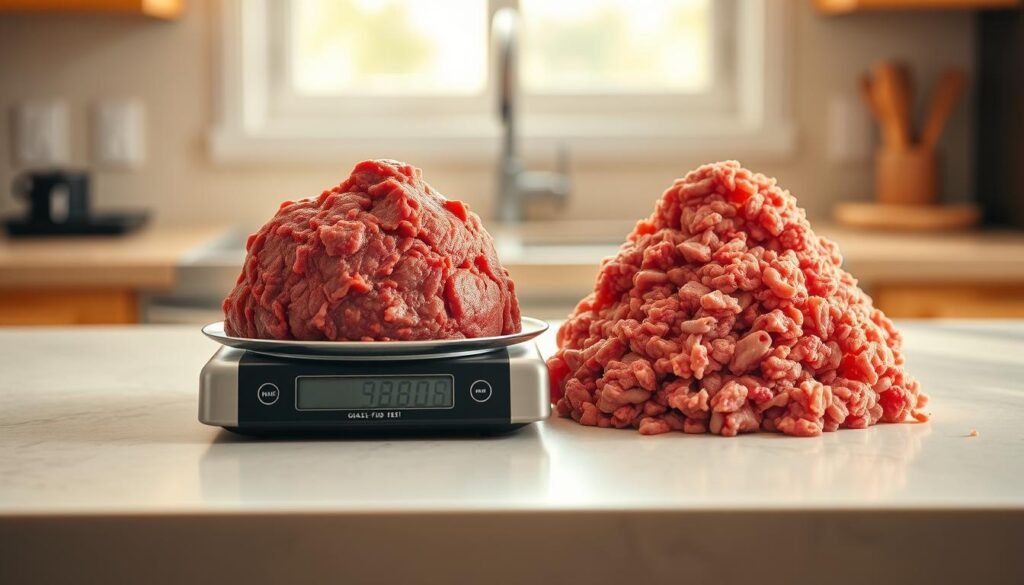
Choosing the right ground beef is key to great flavor and texture. I look at the lean-to-fat ratios first. For example, 85/15 means 85% lean and 15% fat. This mix is perfect for a tasty dish without being too greasy.
If I want a juicier burger, I might choose 70/30 or 80/20. For lighter dishes, 90/10 is a good choice.
Understanding Different Lean-to-Fat Ratios
The lean-to-fat ratio greatly affects how the meat cooks. Here’s a quick guide to common ratios:
| Ratio | Lean Meat (%) | Fat (%) | Ideal Use |
|---|---|---|---|
| 90/10 | 90 | 10 | Health-conscious dishes |
| 85/15 | 85 | 15 | Meatballs, tacos |
| 80/20 | 80 | 20 | Burgers, meatloaf |
| 70/30 | 70 | 30 | Highly flavorful dishes |
Benefits of Grass-Fed vs. Conventional Beef
The type of beef can change how my dishes taste and their nutritional value. Grass-fed beef often tastes richer. It also has more omega-3 fatty acids than conventional beef.
Knowing these differences helps me choose the best beef for my recipes.You can learn more about how to cook prime rib.
Essential Cooking Tools for Ground Beef
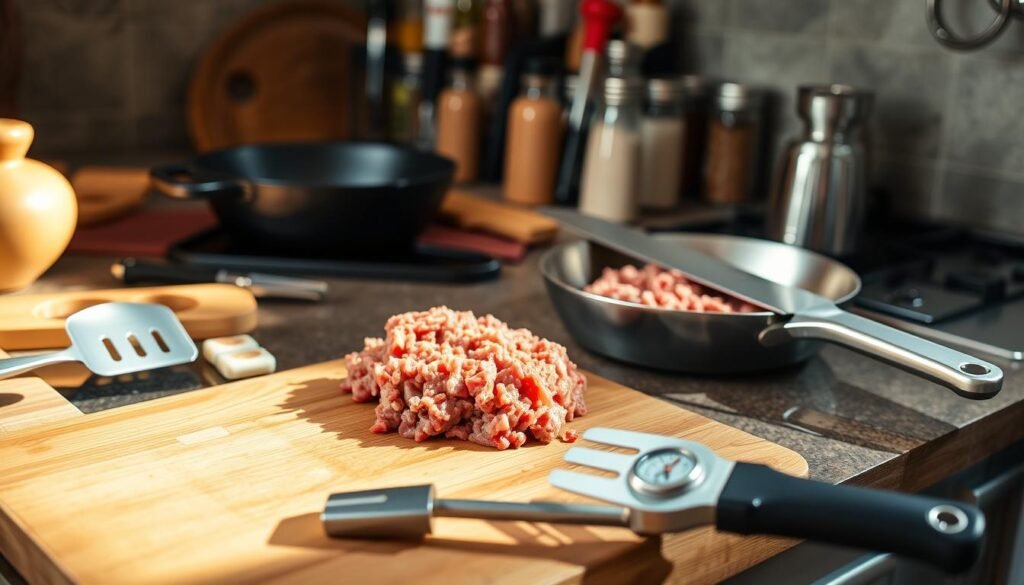
Having the right tools is key when cooking ground beef. Quality tools make the process easier and improve the taste. Here are some must-haves for the best results.
Must-Have Utensils for Cooking
When cooking ground beef, certain utensils are crucial. They help break down the meat and ensure it cooks evenly. I always have these tools ready:
- Spatula: Great for flipping and stirring the beef.
- Wooden Spoon: Ideal for mixing in spices and ingredients.
- Meat Chopper: Essential for finely chopping the beef.
Recommended Cookware Options
Choosing the right cookware is important for ground beef. I prefer heavy-bottomed skillets or cast iron pans. They heat evenly and brown the meat well. Here’s a table with some top cookware options:
| Cookware Type | Benefits |
|---|---|
| Cast Iron Skillet | Excellent heat retention and browning capability. |
| Non-Stick Frying Pan | Easy cleanup and reduces sticking. |
| Stainless Steel Skillet | Durable and ideal for searing meat. |
| Heavy-Bottomed Sauté Pan | Even heat distribution for consistent cooking. |
Preparing Ground Beef for Cooking
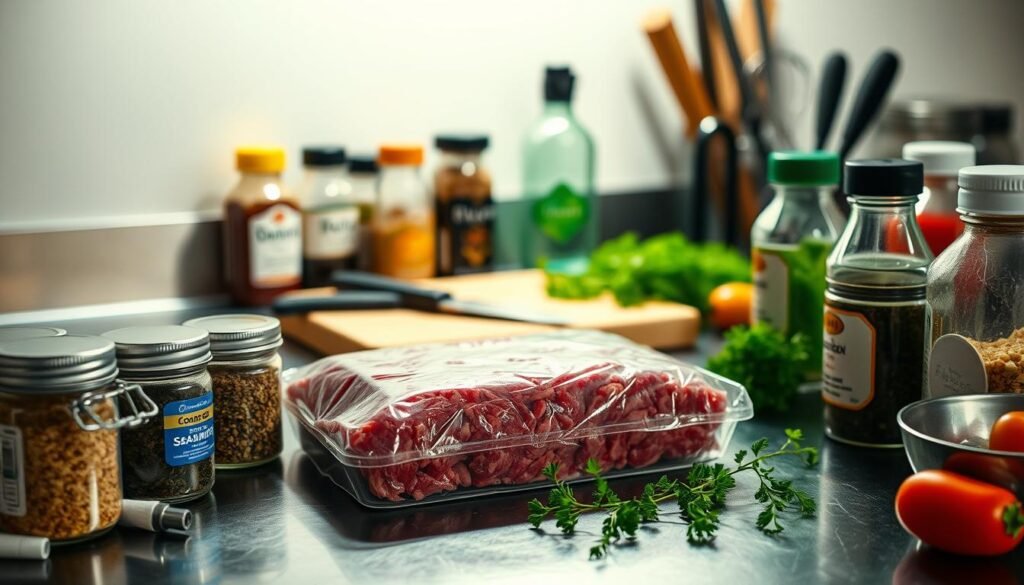
Getting ground beef ready for cooking is key to a great meal. By thawing it safely and seasoning it well, I make sure my dish is both tasty and safe. Thawing it right is crucial for food safety, and the right seasonings can take any dish to the next level.
Thawing Frozen Ground Beef Safely
Thawing frozen ground beef in the fridge is my top choice. Thawing it at room temperature can lead to harmful bacteria. So, I let it thaw slowly in the fridge for hours.
If I’m short on time, the microwave’s defrost function is a good backup. But, I always cook it right away to stay safe.
Seasoning Options to Enhance Flavor
After thawing, it’s time to season the ground beef. Simple salt and pepper can be amazing, but I like to add more. Garlic powder gives it a nice aroma, and chili powder adds a spicy kick.
These seasonings not only make the meat taste better but also match well with the dishes I’m making. It makes every bite special.
Basic Cooking Techniques for Ground Beef
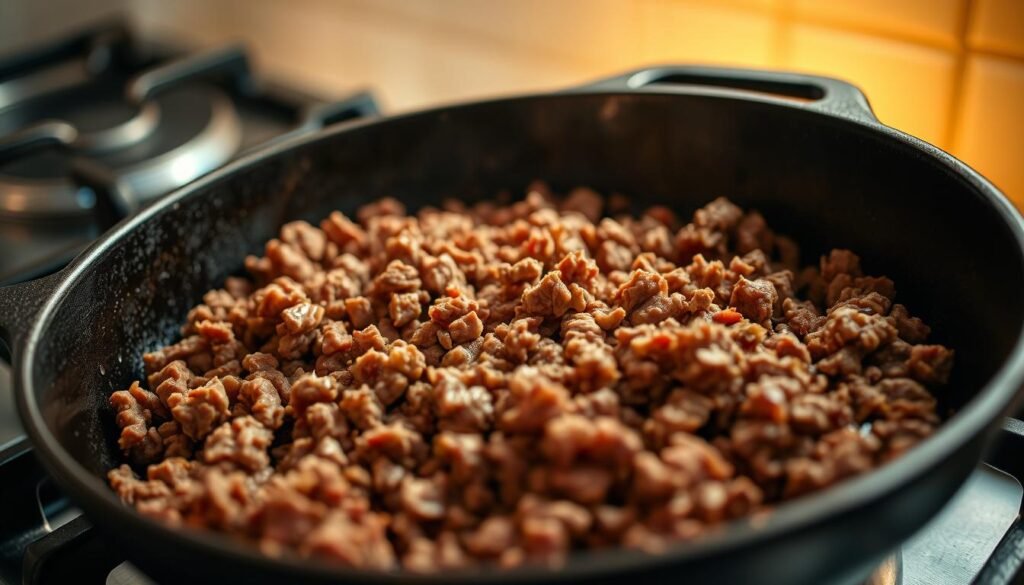
Mastering different cooking techniques is key to making ground beef delicious. Sautéing and browning are two essential methods. Let’s dive into these techniques.
Sautéing Ground Beef: Step-by-Step
First, heat a skillet over medium-high heat and add a tablespoon of oil. When the oil starts shimmering, add the ground beef. Press it into an even layer and let it cook for about four minutes without stirring.
This step helps create a flavorful crust. After four minutes, break the meat apart and keep cooking until it’s fully browned and no pink remains.
Browning Ground Beef for Optimal Flavor
Effective browning techniques are vital for rich flavors in ground beef. Start with a hot pan to enhance the Maillard reaction. This reaction adds savory taste and texture.
Don’t stir the beef too much at first. Let it sear properly for a deeper flavor. Once it’s nicely browned, stir it and cook until it reaches your desired doneness.
Delicious Ground Beef Recipes to Try
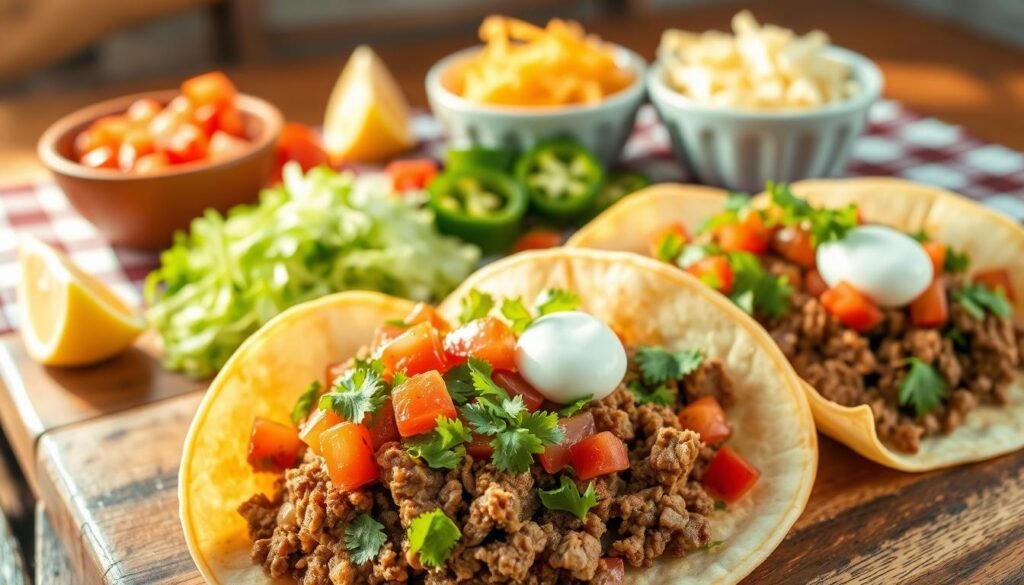
Ground beef is a must-have in my kitchen. It’s great for making many tasty meals. My top picks are a classic beef taco recipe and a hearty beef chili. Both are easy to make, filling, and great for sharing with loved ones.You can learn more about how to cook rice
Classic Beef Tacos Recipe
This beef taco recipe is easy yet full of flavor. It lets everyone add their favorite toppings. I season the ground beef with spices and cook it until it’s brown and tasty.
Once the beef is done, I serve it in warm tortillas. I add toppings like shredded cheese, lettuce, diced tomatoes, and fresh cilantro. It’s perfect for any day or gathering!
Hearty Beef Chili: A Family Favorite
On chilly days, my beef chili recipe is a go-to. It’s a comforting dish made with ground beef, beans, tomatoes, and spices. I simmer it until all the flavors blend together.
I often serve it with cornbread or over rice. It’s a hit with everyone, offering a hearty and delicious meal.
| Recipe | Main Ingredients | Cooking Time | Servings |
|---|---|---|---|
| Classic Beef Tacos | Ground beef, taco seasoning, tortillas, toppings | 20 minutes | 4 |
| Hearty Beef Chili | Ground beef, beans, tomatoes, chili spices | 1 hour | 6 |
Ground Beef in International Cuisine
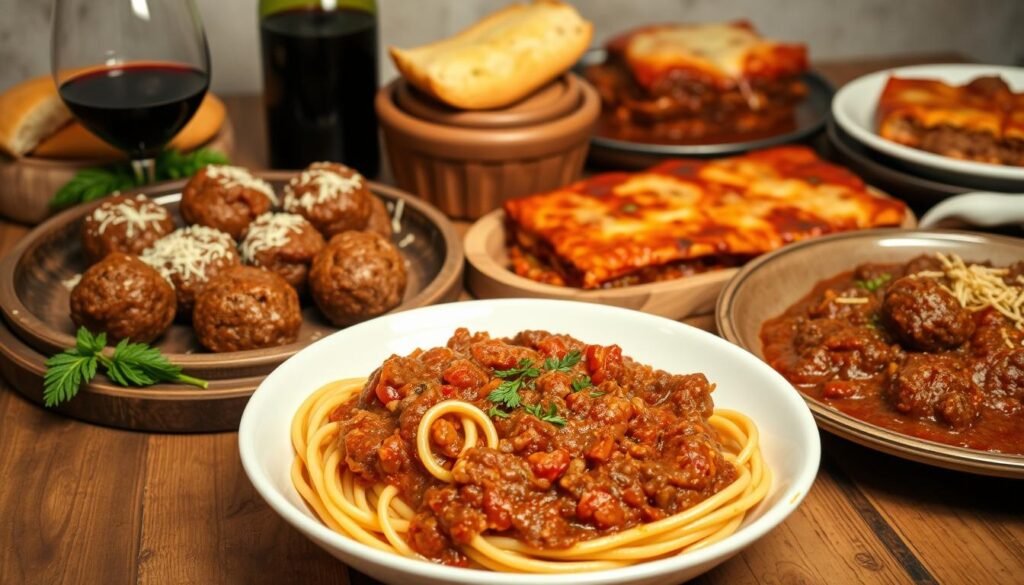
Ground beef is key in many international dishes, adding flavor and versatility. It’s found in Italian Bolognese sauce and Korean beef bowls. These dishes highlight different cultures and cooking styles.
Exploring Italian Bolognese Sauce
Italian Bolognese sauce is a classic that shows ground beef’s power. It’s slow-cooked, blending flavors into a rich sauce. This sauce is great with pasta, made with tomatoes, onions, and herbs.
Making this sauce is easy and rewarding. It fills your home with a wonderful smell.
Flavorful Korean Beef Bowls
Korean beef bowls are quick and tasty for weeknights. They use ground beef marinated in soy sauce, garlic, and brown sugar. Served with rice, the flavors mix well, making it a hit at home.
Looking for more ground beef recipes? There are many options that use ground beef in creative ways.
Storage Tips for Cooked Ground Beef
Storing cooked ground beef right can really improve its taste and safety. I always follow the best methods to keep my meals fresh and tasty. Here are some tips for storing ground beef and making it last longer.
Best Practices for Refrigeration
Cooked ground beef can stay in the fridge for 3 to 4 days. I store it in an airtight container or wrap it tightly with plastic wrap. It’s crucial to keep the fridge at 40°F (4°C) or lower to slow down bacteria.
It’s also important to cool the beef quickly before refrigerating it. This helps prevent spoilage.
Freezing Cooked Beef for Later Use
Freezing cooked beef is a great way to keep it safe and tasty for up to three months. I divide it into small portions for easier use later. Using freezer-safe containers and labeling them with the date is key.
This method not only helps in freezing cooked beef efficiently but also ensures quality when I use it. For more detailed guidelines on how long cooked ground beef lasts, I refer to this helpful resource.
When storing cooked ground beef, I always avoid cross-contamination. It’s important to keep cooked beef separate from raw meat to prevent health issues. Knowing the signs of spoiled beef, like discoloration or a sour smell, also helps me ensure safety and enjoyment.
Common Mistakes to Avoid When Cooking Ground Beef
Cooking ground beef is simple, but many mistakes can ruin it. These errors can make your dish dry and tasteless. Knowing a few key techniques helps avoid these problems.
Overcooking: How to Prevent It
Overcooking is a big challenge with ground beef. It’s crucial to watch the cooking time closely. Start with a hot skillet to brown the beef quickly.
The beef should reach 160°F (70°C) inside. A meat thermometer helps you avoid overcooking. For more tips, see this guide on browning ground beef.
Avoiding Dryness: Tips for Moist Beef
To keep beef moist, pay attention to its fat content. An 80/20 ratio is best for flavor without greasiness. Seasoning at the right time adds flavor without drying it out.
Using fats like oil or butter helps keep it moist. Don’t rinse cooked beef to avoid losing flavor and risking food safety. For more on cooking mistakes, read this article.
Creative Ways to Use Leftover Ground Beef
Leftover ground beef can make everyday meals exciting. It’s great in casseroles and pasta dishes. These leftover ground beef recipes turn simple ingredients into gourmet dishes.
Ground Beef in Casseroles and Pasta Dishes
Leftover ground beef is perfect for casseroles. It can be layered in baked ziti or turned into a hearty shepherd’s pie. The flavors blend well, making it hard to tell it’s from last night’s dinner. Other tasty options include:
- Italian stuffed peppers
- Beef chili, perfect for two
- Spanish rice with ground beef
Casseroles are comforting and quick to make. For more ideas, check out leftover ground beef recipes.
Incorporating Leftovers into Breakfast
Leftover ground beef is also great for breakfast. I mix it into omelets or add it to burritos for a filling start. This way, I reduce waste and make breakfast more exciting. Quick options include:
- Taco breakfast burritos
- Ground beef hash
- Scrambled eggs with beef and cheese
These ideas can change my breakfast routine. With a bit of creativity, I can use leftover beef to make satisfying meals. This way, every bit of beef is used to its fullest potential!
Final Tips for Perfectly Cooked Ground Beef
When cooking ground beef, following a few simple tips is key. Always check the internal temperature beef reaches 160°F. This ensures the meat is safe and still juicy and flavorful.
I also enjoy trying different marinades and spices. This lets me create unique flavors in my dishes. From garlic and onion powder to cumin and paprika, each mix makes my meals special. For more tips, check out this guide on cooking ground beef tips.
In summary, mastering cooking techniques and adding diverse flavors can make any ground beef dish better. By focusing on the right temperature and experimenting with seasonings, meals become a joy for everyone.
FAQ
What is the best lean-to-fat ratio for ground beef when making burgers?
For juicy burgers, choose ground beef with a lean-to-fat ratio of 80/20 or 70/30. This ratio keeps the burgers moist and full of flavor.
How do I properly thaw frozen ground beef?
Thaw frozen ground beef safely in the fridge for several hours or overnight. This method prevents harmful bacteria from growing, unlike thawing at room temperature.
What are some creative ways to use leftover ground beef?
Use leftover ground beef in casseroles, pasta, or even breakfast dishes like omelets and burritos. It’s a versatile ingredient that can make many meals special!
How can I avoid overcooking ground beef?
To avoid overcooking, watch the cooking time closely. Use a meat thermometer to check for an internal temperature of 160°F. Also, avoid stirring too much to prevent dryness.
What seasonings can enhance the flavor of ground beef?
Simple seasonings like salt and pepper are good, but try garlic powder, onion powder, or chili powder for more flavor. You can also experiment with herbs and sauces for unique tastes.
How should I store cooked ground beef?
Store cooked ground beef in an airtight container in the fridge and use it within a week. For longer storage, freeze it for up to three months to keep its quality.
Can I marinate ground beef before cooking?
Yes, you can marinate ground beef to add more flavors. Just remember not to marinate for too long, as it can make the meat too tender.
